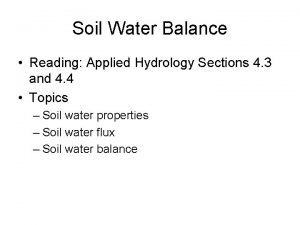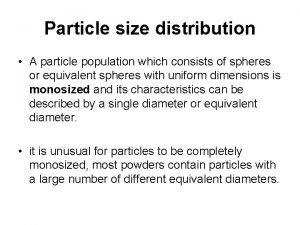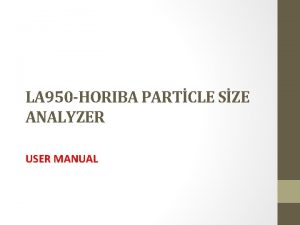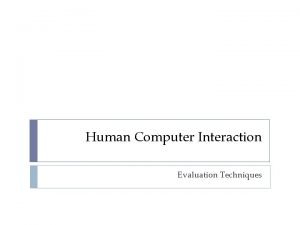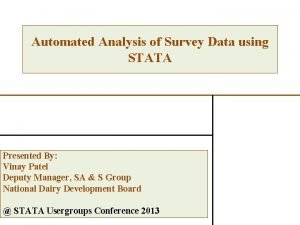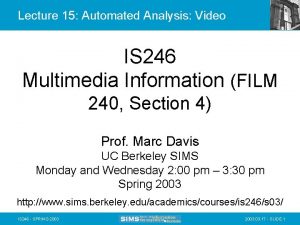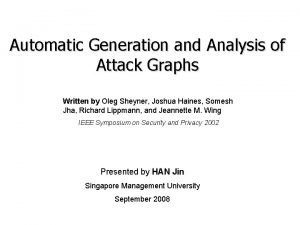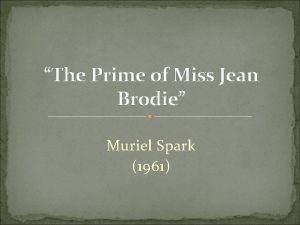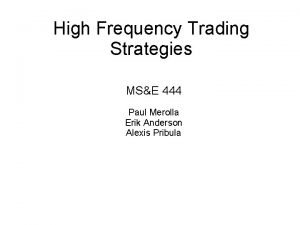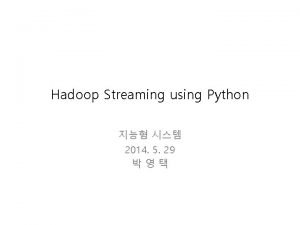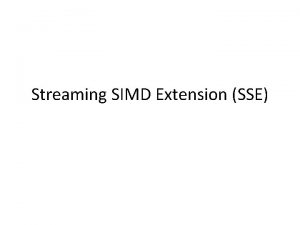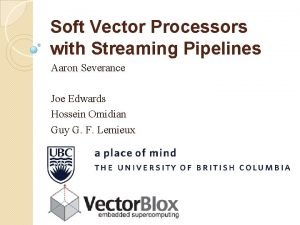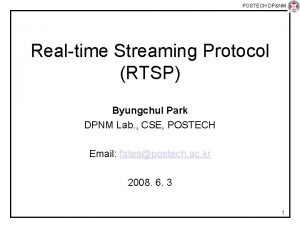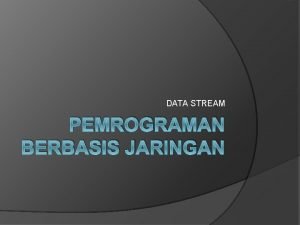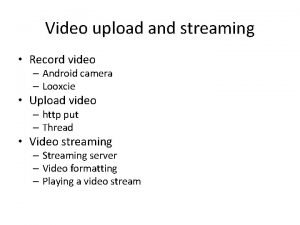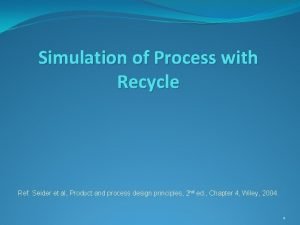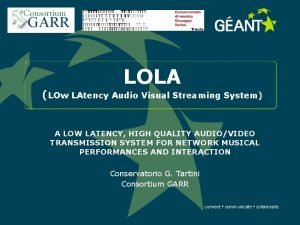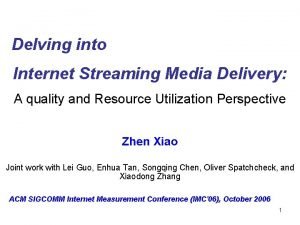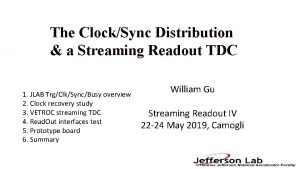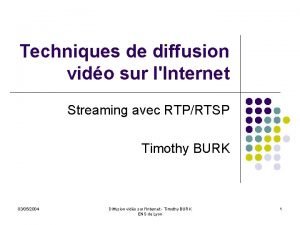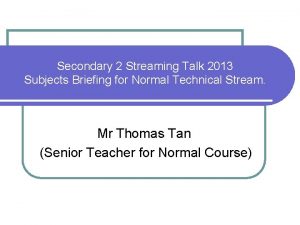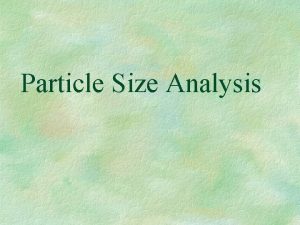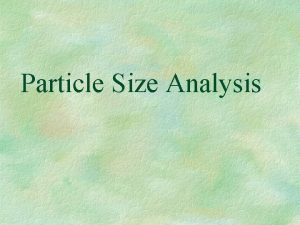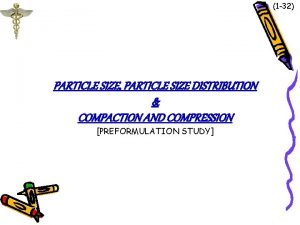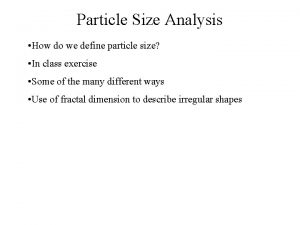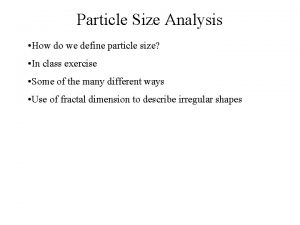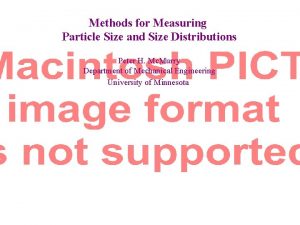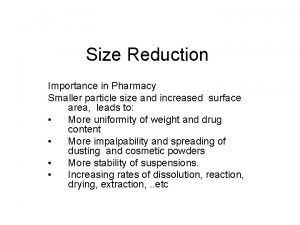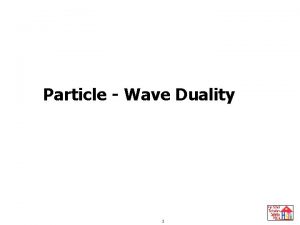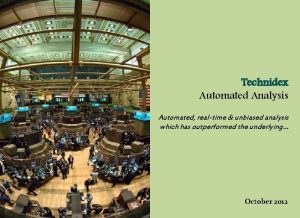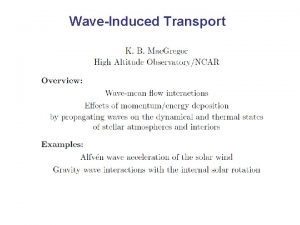Automated Particle Size Analysis goals streaming analysis concepts














































- Slides: 46

Automated Particle Size Analysis goals streaming analysis concepts automated approaches sedimentation, laser light, and other techniques contrast and compare techniques examine particle size distributions, data

Automated Particle Size Analysis • • usually streaming technique powder dispersed in fluid – water if suitable slurry (1 % powder) passed through sensor signals related to particle size – light scattering – settling time all assume – X-ray attenuation spherical shape – light blocking – electrical conductivity change – laser Doppler shift 2

Sedimentation • based on Stokes’ Law – terminal velocity v • balance of forces • viscous drag, gravity, buoyancy v = g D 2 ( M - F)/(18 η) v = velocity of settling D = particle size M = solid material density F = fluid density η = fluid viscosity 3

Stokes’ Law • • • assumes sphere instant attainment of terminal velocity viscous (low Reynolds number) no Brownian motion typical test – disperse particles, settle distance H in time t – calculate particle size distribution by arrival times – use optical, X-ray, mass (Turbidmeter, 4 Sedigraph, Micromirrograph)

Light Scattering and Diffraction relies on Fraunhofer and Mie scattering automated large dynamic range - 7000 5

Particle Size – Angle and Intensity assume sphere collect angle and intensity data stream millions of particles through detector 6

Automated Analysis computerized data acquisition of angle and intensity data – extract particle size distribution assume spheres 7

Electrical Zone Sensing red blood cells (5 -7 µm) Coulter Counter 8

Particle Size Detection aperture limits size range measures volume, assumes sphere must use multiple apertures dynamic ratio = 27 9 plugs with large particles

Benchtop Instrument electrical isolation to avoid noise 10

Light Blocking limited by wavelength of light, usually 1 µm up, counts number of particles and shadow size, assumes spherical 11

Example shadow gives size indication 12

Time of Flight measures velocity after launch at mach 2 measures hydraulic diameter assumes sphere 13

Doppler Scattering – Brownian Motion Stokes-Einstein equation, Doppler shift in laser depends on particle velocity Brownian velocity varies with inverse of particle size assumes sphere good from 5 nm to 5 µm 14

X-Ray Techniques • small angle scattering – can capture size information • peak broadening – at Bragg condition n = 2 dhkl sin( ) – small crystals broaden peak – use calibration source – Scherrer formula D = 0. 9 /(B cos( )) 15

X-Ray Line Broadening usually measure peak breadth at half maximum intensity subtract instrument error 16

Contrast and Comparison 17

Particle Size Distribution • approaches generate size distribution data • two common plots – histogram (bell curve) – cumulative (continuous) • two metrics – population (or number of particles) – mass (weight of particles) • usually condensed into few parameters 18

Histogram Particle Size Data log size scale gives equal spaces mode 19

Cumulative Particle Size Distribution cumulative sum of mass over all classes standard deviation median 20

Standard Deviations and Percentages • deviations • -2. 0 • -1. 5 • -1. 0 • -0. 5 • 0. 0 • 0. 5 • 1. 0 • 1. 5 • 2. 0 cumulative percentage 2. 28 6. 68 15. 87 31. 85 50. 00 69. 15 84. 13 93. 32 97. 72 21

Log-Normal Distribution 22

Distribution Display Options skewed on linear scale histogram, bell curve log size scale, 0 to 100% smaller than, cumulative linearized form, standard deviations vs. log size 23

Common Distribution Types log-normal, Gaussian with log size scaling polydisperse very broad monosize nearly all same size bimodal mixture of two sizes 24

Comparison – Mass and Population many small particles equal mass of one large particle 25

Distribution Statistics • • possible metrics mean mode median = D 50 90% size = D 90 10% size = D 10 SW = distribution width SW = 2. 56/[log 10(D 90/D 10)] 26

Example Range for Iron Powders 27

Problems in Particle Sizing • population and mass distributions – n = number of particles = 6 W/( M D 3) – W = weight – D = particle diameter – M = material density • bias toward measuring larger particles • dynamic ratio • resolution • poor calibration • everything is assumed a sphere – major error 28

Why is Particle Sizing so Inexact? • many measures of particle size – even for a single particle • error sources – agglomeration – coincidence – blocking – calibration – dispersion – assumed shape (shape not measured) – unclear attributes (area, volume, mass) 29

General Accuracy • repeated tests – same person, same powder, same machine – 4 to 10% variation • different labs, different people, different machines, and different techniques – easily 10% variation • real accuracy is probably ± 10% 30

Error Analysis same powder different machines note median not bad, but tails are highly variable 31

Monthly Variations 32

Example Powder mass based particle size analysis, laser scattering assumed spherical 33

Why Change a Powder • • improved flow, faster flow, more productivity remove contaminants, improve safety classify, remove agglomeration remove contaminated powders better packing, more uniform packing mixing different chemistries – form composites – form alloys blending different lots or sizes adding lubricants, binders 34

Health Concerns • breathing – no issue with larger particles (unless toxic) • small particles – below few micrometer – deposit in lungs – react (corrode) – physiological reaction • nanoscale particles – below 100 nm – absorbed into cells – can be very toxic – considerable concern, possible banning 35

Safety Concerns • • high surface area – energy rapid oxidation exothermic heating explosions – Al plants blow up – Be, Ti, Zr, similar metals • problem with dispersed powder – and reactant source (oxygen or nitrogen) – and spark, heat, or electrical discharge 36

Pyrophoric – Burn in Air 37

Pyrophoric and Exothermic Reactions pyrophoric = react to burn in air – aluminum plus oxygen to form alumina generates pressure wave exothermic = react as solids form compound, liberate heat – nickel and aluminum form nickel aluminide and excess heat preventative measures? 38

Glove Box Handling 39

Agglomeration • natural weak bonds – can break apart with shear • aggregates – sinter bonds (particles sinter in synthesis) – can not break apart – must mill • moisture (polymers) – pendular bonds – F = 3 D LV F = force, D = particle size, LV = liquid-vapor surface energy 40

Pendular Bond – Wetting Liquid small moisture levels greatly change a powder 41

Spray Dry Agglomeration powder – solvent – polymer slurry formed into balls 42

Fluid Bed requires particles are nearly all the same size (otherwise elutriation) spray solvent-polymer onto levitated powder 43

Spouted Bed allows for range of particle sizes superior to fluid bed for coating and agglomerating 44

Intentional Agglomeration electrostatic agglomeration of alumina (0. 4 µm) spray dry agglomeration of WC-Co 45

Summary • • • particle size and distribution important many ways to measure clarify measure, property, technique condense to few specifics changes for health, handling, safety 46
 Strategic goals tactical goals operational goals
Strategic goals tactical goals operational goals Strategic goals tactical goals operational goals
Strategic goals tactical goals operational goals Soil particle size classification
Soil particle size classification Coulter counter method
Coulter counter method Horiba la-950
Horiba la-950 Pyspark twitter sentiment analysis
Pyspark twitter sentiment analysis General goals and specific goals
General goals and specific goals Examples of generic goals and product-specific goals
Examples of generic goals and product-specific goals Query techniques in hci
Query techniques in hci Automated survey analysis
Automated survey analysis Automated financial analysis
Automated financial analysis Automated malware analysis system
Automated malware analysis system Automated video analysis
Automated video analysis Automated generation and analysis of attack graphs
Automated generation and analysis of attack graphs Const char *s =
Const char *s = Importance of size separation
Importance of size separation Ball setting and streaming
Ball setting and streaming Handling of time in the prime of miss jean brodie
Handling of time in the prime of miss jean brodie Dash dynamic adaptive streaming over http
Dash dynamic adaptive streaming over http Xxnx ica
Xxnx ica Hadoop streaming python
Hadoop streaming python United streaming discovery
United streaming discovery Streaming telemetry
Streaming telemetry Simd
Simd Streaming current detectors
Streaming current detectors Severance streaming
Severance streaming Realtime streaming protocol
Realtime streaming protocol Multimedia streaming protocols
Multimedia streaming protocols Ll-hls
Ll-hls Konsep stream
Konsep stream Record streaming video android
Record streaming video android What is a tear stream in aspen
What is a tear stream in aspen Subject combination sec 3
Subject combination sec 3 Osama streaming
Osama streaming Playcast-media.com
Playcast-media.com Video streaming viva
Video streaming viva Dyonisies
Dyonisies Low latency audio streaming
Low latency audio streaming Streaming media delivery
Streaming media delivery Wyse streaming manager
Wyse streaming manager Streaming xml parser
Streaming xml parser Cytoplasmic streaming
Cytoplasmic streaming Tdc streaming
Tdc streaming Streaming
Streaming Secondary 2 streaming
Secondary 2 streaming Anonymous@
Anonymous@ Hadoop assignments with solutions
Hadoop assignments with solutions


